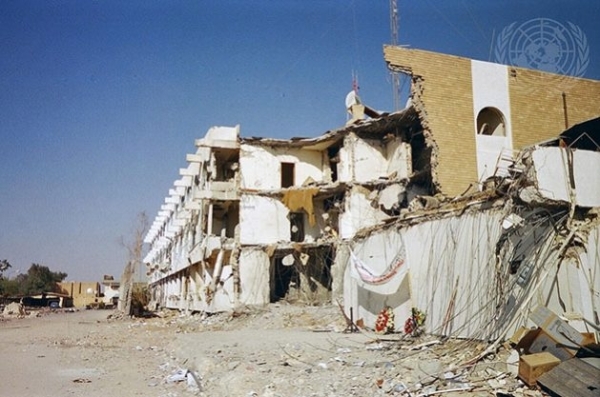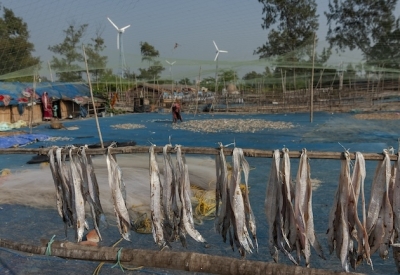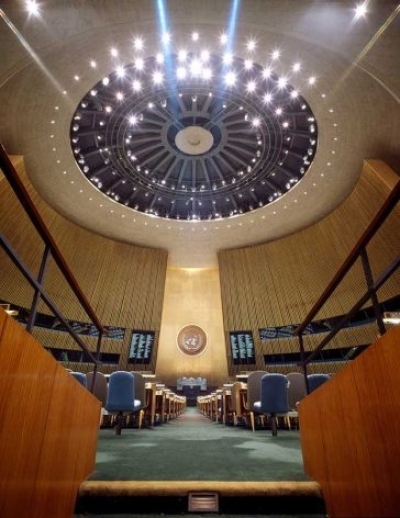NEW YORK, Sep 08 (IPS) — Twenty years ago this month, a colleague saved me from a likely gruesome death. He insisted I stay in his Baghdad office of the World Food Programme (WFP) for a hot drink. “You can’t leave us without trying the tea I made for you! The best in Iraq.”
I drove back to my office half an hour later than scheduled. Near the grim building of the Canal Hotel, the UN headquarters in the Iraqi capital, I caught sight of a column of smoke and a grey cloud forming on the horizon.
A tragedy was unfolding. People were shouting and crying, while dust, sweat and the scent of molten iron irritated my eyes and nostrils. An American soldier stopped me, brandishing his weapon. He and his unit usually stood idly by their armoured vehicle, leaving the main entrance under the care of local security men. “Let me through, this is my office, I work here!!”
The soldiers didn’t speak or argue; they were tense and firm as they held their weapons in a ready position. What happened while I was away? Why couldn’t I get into my office? I felt an urge to force my passage through the soldiers, to enter the apocalyptic grounds.
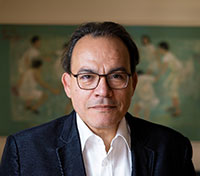
The gate at the back of the compound was open.
Inside, survivors were scattered, their faces pale and covered with a film of dust, sweat and blood. Many were sitting on the grass scorched by the summer heat in the spacious garden or on the grounds of the parking lot, staring into nothingness, while others trembled in tears as they embraced each other.
“Sérgio is dying,” cried a colleague before collapsing into my arms.
I slipped through a small back door and onto my office on the second floor. The broken glass of shattered windows crushed under my feet as I cautiously took one step after another in dim dusty corridors. I passed over doors torn off their hinges by the force of the blast, thrown onto the ground or leaning against the wall. Desks, drawers, shelves and paper littered the corridors.
My laptop was there but many keys had popped out due to the force of the explosion. Large, sharp glass fragments had lodged in the back of my chair. Had I been there, any of them could have pierced my back.
I walked in darkness until a soldier stopped me at the office of Sérgio Vieira de Mello, the head of the UN mission in Iraq. De Mello had been sent there a few weeks earlier by the then UN Secretary General Kofi Annan. His mission was to help the invading Americans reach a political way out and hand over power to Iraqis, after the military and political foundations of Saddam Hussein’s regime had been destroyed earlier that year in an ill-conceived and illegal war that had not even been sanctioned by the UN Security Council.
I asked the soldier to let me through. With a vacant look in his eyes, he said, “There’s no ‘through’. There is nothing there; that part of the building is vaporised. If you stepped behind that door, you’d fall several stories onto rubble, iron rods, and concrete blocks.”
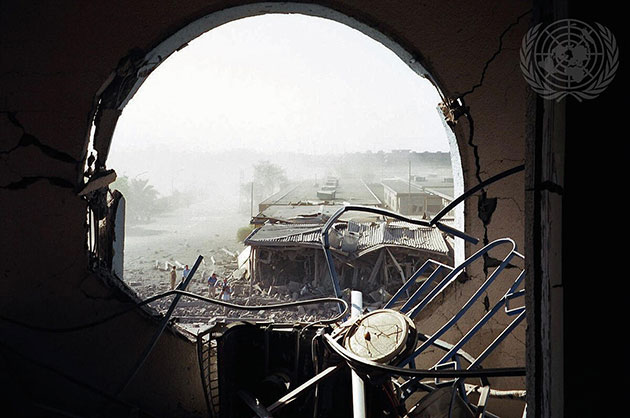
I entered the adjacent office where a colleague and I used to smoke whenever we had the chance. Her cigarettes and lighter were on her desk covered by a thin layer of dust that enveloped everything in the room. She was among the missing, and I would later learn that she died in the explosion.
What I had missed
It took hours for us to piece the initial story together. Around 4:30pm on 19th August, 2003, a suicide bomber drove a truck heavily loaded with explosives into the UN compound. His deadly cargo detonated upon impact, destroying a whole corner of the building, burying those inside it under the collapsed floors. The attack killed 22 people, most of whom were UN staff members.
I spent the evening that day in a UN vehicle with colleagues moving from one hospital and medical centre to another, checking on the wounded and searching for some missing UN staff. We ferried some walking wounded back to their hotels.
For a few days, we worked all our waking hours, surrendering ourselves to an immense flow of adrenaline, meetings, calls, and emails.
There was no time to be angry about the UN failure to anticipate the attack or better protect its staff. There was no time to be angry at the mindless, murderous terrorists, or to contemplate the role of the US invasion and the disastrous de-Ba’athification policy, and the emerging Baath/jihadi coalitions which created a wave of terror that haunts the region today. There would be time for that, later.
I remained oblivious to how the attack impacted me psychologically for several weeks until the long-delayed recognition of the enormity of this horror finally arrived after I returned home to New York. I began tough journey of recovery, where I had to deal with survivor’s guilt and disturbing flashbacks, not to mention what happens usually in such circumstances when upsetting memories swept under the rug of the unconscious creep up and pull you down to very dark caves.
I was very fortunate (and the UN was probably very worried about liability and litigation) to be able to have a fully paid year of leave during which I underwent intensive psychotherapy, also paid for by my health insurance. Millions of Iraqis, including UN contractors, were not that lucky.
It took years to fully integrate this harrowing experience and move on. I now accept, rather than avoid, the waves of sadness—and sometimes anger—this memory brings. I know now how not to inflict my suffering on others. This required hard, personal work, and the support and love of friends, family members, and professionals.
I managed to return to work, including in conflict zones, after about a year.
Who was accountable?
The direct responsibility for this horrific attack rested with the terrorist Al-Qaeda group. For them the UN was a proxy target, easier to hit than the US military, which was then their nemesis, but had been an ally of their jihadi ideological fathers in Afghanistan in the 1980s. A wave of propaganda relying on a grain of truth that the UN was whitewashing the American invasion dominated Iraqi and even wider Arab conversations about the international organisation. Al-Qaeda recruiters exploited it cleverly to convince volunteers and followers that the UN was a legitimate target.
In a few months, the UN completed a detailed investigation and pointed the internal fingers of blame at dysfunctional security systems and officials. It shied away from directly blaming the decision-making process for hasty deployment of such political and humanitarian aid missions to danger zones without adequate planning, especially when such decisions were pushed by interested influential capitals.
I remember long discussions among senior UN officials and colleagues before and after the attack on how humanitarian aid had become too politicised and how this had turned us, aid workers, into a soft target for attacks which had been increasingly aimed at civilians and civilian infrastructure.
The day of the attack
On 19th August, 2003, a few hours before the attack, a colleague was trying to park our car inside the UN compound after passing through extensive security checks. As I got out of the car, I noticed a woman and a child behind a side unguarded gate. The child had managed to insert himself in the slight opening of the gate held together by a rusty chain and an old padlock. His slim figure was almost inside the compound when he noticed me. We exchanged conspiratorial smiles. Before he could fully push his body through, his mother grabbed his arm and pulled him back.
I thought I should inform the UN security officer, who was walking towards me, about what had just happened. They had excessive security measures at the main entrance while leaving that side gate easily passable for a small person. Before I could utter a word, the security officer shouted, “Move your car from here, these spots are reserved for the mission leadership!”
We exchanged some terse words. I pointed towards the gate. The woman and the child had already left. I said that this was a serious security lapse. He got angrier and shouted, “This is my job, don’t teach me my job, move your car now!”
A few hours later, the explosives truck drove into this rickety side gate dislodging it.
Undoubtedly, there was a clear failure and negligence on the part of security personnel and systems. Some of them faced subsequent administrative sanctions. However, understanding how the flawed security system allowed the terrorists to easily carry out the attack does not help us understand why they considered and planned such an attack against the UN in the first place.
How the UN became a target
Over the past 30 years, many people, especially in societies that receive aid or are affected by the UN resolutions and interventions, have increasingly viewed the organisation as a part of a scheme to maintain a western-dominated international order. From jihadists and armed militias to aid-receiving governments and communities, the UN has increasingly been perceived as subservient to neoliberal ideologies and western capitalist interests. My colleagues and I have heard this from government officials in Khartoum and Kabul, militia men in Darfur and Faizabad, and from refugees and displaced people in Palestine and Lebanon. Those who receive UN assistance always appreciated the help but often complained that aid had not addressed the root causes of their misery. They sometimes raised doubts about the motives of big aid agencies.
In the face of complex and unresolved conflicts, it is easier to adopt a superficial and simplistic view of how the UN works and claim that its myriad of organisations and programmes are mere tools of western foreign policy. And there is probably a grain of truth to such claims, especially since the end of the Cold War. Western capitals provide over 75 per cent of the funding for humanitarian organisations, they dominate their governance systems, and monopolise the top positions in the most important global humanitarian organisations, namely Unicef, WFP and the UNHCR. The first two have almost always been led by Americans, some of whom had served in senior political positions in their governments.
During the 20th century, the aid enterprise became increasingly intertwined with transnational politics. In addition to altruistic motivations and legal underpinnings, it was also increasingly influenced by realpolitik considerations to ensure that conflicts, poverty, and natural disasters did not undermine the stability of strategically important interests or region.
With the evaporation of the Soviet bloc in the late 1980s, disintegrating states and armed non-state actors emerged as the main threat to the international world order championed by the west. Al-Qaeda, though a former ally of the US in its global anti-Soviet campaigns, attacked the US on the home front. The murderous terrorist carnage on 11th September led to a massive and excessive response by the US and its allies in Afghanistan in 2001 and then in Iraq in 2003. The humanitarian enterprise played a large, albeit secondary, role to mitigate the impact of these wars on civilians. This role was largely shaped and funded by the US and its allies.
Since then, ideologically driven armed militias, remnants of the hard Stalinist left, and also some liberal and realist circles, started to perceive UN organisations as largely dominated by western capitals, and as a part of their toolbox in global undertakings, whether peaceful or military.
These are factual elements that fed the conspiratorial world view which enabled the bombing of Baghdad UN offices 20 years ago.
Modern humanitarian aid has not been free from political prerogatives since its formal evolution in the early 20th century. It became one of the Cold War battlegrounds after World War II. Then it metamorphosed again in the 1990s following the collapse of the Soviet Union, as the dominant powers tried to subject it to their national priorities. This was evident in several conflict areas in the 1990s. For example, in the Balkans, the UN created safe havens to partly prevent the flow of refugees to western Europe. While food and shelter were provided, protection was not available, resulting in the deaths of thousands of Bosnians in places like Srebrenica.
Humanitarian organisations operate in a hyper-political environment while striving to adhere to principles of neutrality, independence, and impartiality. It is true, however, that UN senior leaders and staff on the ground can sometimes take inappropriate decisions and carry out their work in ways that are inconsistent with UN values. Such actions taint the entire UN and contributes to blanket perceptions such as “the UN is corrupt”.
None of this is to excuse, much less justify, a vicious strategy by armed groups involved in acts of terror that target international aid groups. It is to try to understand the environment in which these groups recruit and operate. It is also to show how innocent people can be crushed between the political machinations of the international community and the armed groups (or states) that control their lives.
How the train of politics twisted the tracks of humanitarian work
The politicisation of humanitarian aid was evident when I joined the UN in 1999 in Afghanistan, where the Taliban on the ground and donors in Washington and other capitals held many of the levers for the allocation and delivery of aid.
After 11th September, meetings with USAid in Islamabad focused on trying to prevent a humanitarian catastrophe in Afghanistan after the US invasion. Afghanistan was already suffering from cyclical droughts, poor social services and a crumbling economy after being dominated by armed conflict for decades. They did not want to allow the Taliban to use the humanitarian cost of the war against them. The UN flooded the country with flour, oil and essential food items, and the feared famine never materialised.
Aid politicisation went into a higher gear of integration in 2002, during the months leading up to the Iraq War. The then US Secretary of State Colin Powell believed that foreign aid provided political incentives, supported free market democracy, and helped counter disorganised transnational migration.
In the autumn of 2002, humanitarian plans by UN organisations were shared with Washington. Before the war broke out organisations sought firm financial commitments from the US to start pre-positioning supplies.
Predictably, the shift in Middle Eastern and South Asian public opinion against the UN and aid agencies continued with rising allegations of bias and subservience to western interests. The complexity of functions, the competition for funding and a perception of clashing roles and priorities within UN organisations further complicated efforts to counter these allegations.
For example, the UN Security Council has at various stages imposed sanctions on Iraq, Afghanistan, Sudan and Syria—measures that have severely affected the civilian populations rather than the targeted regimes and their proxies. Meanwhile, UN aid organisations like Unicef, the UNHCR, and the WFP continued to spend hundreds of millions of dollars (the total global budget of these organisations in 2022 exceeded $26bn) on millions of refugees, internally displaced persons and those harmed by the war and by these very sanctions.
Some of the five permanent members of the United Nations Security Council, notably Russia and the US, have been implicated in strikes on medical and health facilities during conflicts in Syria, Iraq and Afghanistan, launching drone attacks against enemy targets killing many civilians in the process (what they call collateral damage), assassination attempts against opponents and arbitrary detentions. At the same time, they joined other western countries and Japan in providing the largest share of humanitarian needs (over $20bn in 2022 ), sometimes in the same places where they carry out or support seemingly endless military conflicts, such as in Yemen, Syria and Afghanistan.
These examples illustrate the complexity of behaviours of states and international organisations driven by often clashing motives and considerations.
However, in an era of dis- and misinformation and the quest for the ultimate sound bite, it becomes easier to view the UN as a failed international humanitarian conglomerate serving western political interests, incapable of leading the world to achieve just peace, enhance sustainable development or better protect human rights. (These were the three main pillars of the UN when its charter was put together after World War II.)
On the other hand, the authorities in recipient countries influence decisions about aid distribution: who receives assistance and who gets local contracts. A well-documented report in 2022 about aid operation in Syria revealed transactions involving tens of millions of dollars between UN organisations and private sector companies, some of which were owned or controlled by security agencies or senior Syrian officials who had been subject to western sanctions. These companies received around 47 per cent of the total UN contracts in 2019 and 2020.
Until the bombing of the UN headquarters in Iraq in 2003, humanitarian workers took simple and logical security precautions—most notably, the display of their insignias on their offices, homes, and vehicles. The message that we, the UN, were neutral and impartial largely worked.
This started to change in the 1990s and early 2000s with new concepts such as the Responsibility to Protect, which started to give the UN a role that could be seen as interventionist. The reputation of UN organisations started to suffer. Many people, especially in recipient communities, increasingly perceived the UN as a western agent or a weak, subservient actor. Those who work with the UN have consequently become easier targets for criticism and, tragically, attacks.
In 2000 and 2001, I rode in rundown yellow taxis to go to the market in Kabul, where Taliban soldiers roamed the streets. I drove my own car bearing UN license plates to tribal areas in Pakistan, where jihadist groups, drug gangs, and arms dealers were present.
A few years later, during my missions in conflict zones, I needed security clearances to be able to leave my well-fortified offices. I wore a bulletproof vest and used two cars, one of them armoured, to attend meetings.
Relief workers started to be separated from people they were meant to assist, not merely by protective helmets and vests, but they also stayed inside homes and offices surrounded by sandbags and shock-absorbing barriers. These buildings became isolated behind barbed wires and high-security systems in locations far removed from the communities they were meant to serve. The walls around UN offices grew taller, and most of those working in conflict zones moved to live within fortified sanctuaries. International organisations also sent fewer international staff to unsafe areas.
All these changes help explain the decrease in casualties among foreign relief workers.
In 2003, a total of 117 local relief workers were killed, injured, or abducted, compared to 26 of their international colleagues. By 2022, the number of casualties among local workers had risen to 421, while the number of foreign relief worker casualties had decreased to 23. It is evident that the risks have increased, but their distribution has radically reversed, with local workers bearing much more of the burden.
Why I returned
My actual return to work in 2005 did not mean that I returned to who I was on the morning of 19th August, 2003, before the Baghdad attack occurred. In addition to my emotional and psychological shifts, I have also become more aware of limitations of humanitarian interventions and the urgent need for reforms in the international aid system.
By the time I decided to leave the UN in 2013, I had voiced almost all my concerns about the aid industry while working within the system.
Now, on the anniversary of the Baghdad explosion that I survived, I think a lot about the person I was 20 years ago when I lost 22 of my colleagues. I reflect on the price I paid and how much I have changed. I cherish the memory of friends and colleagues who lost their lives, were wounded or abducted over the past two decades—around 6,000 of them. The most recent was my late colleague, Moayad Hameidi, the head of the World Food Programme office in Taiz, Yemen, who was gunned down in late July. He survived Iraq but not Yemen.
The senseless Baghdad explosion compelled me to change, hopefully for the better, but the UN has been much slower in reforming itself while fully adhering to the principles on which it was founded—most importantly, humanity. Overhauling massive institutions might be much harder than healing and changing individuals. Perhaps our only choice here is to continue to work patiently to advance reforms step by step, programme after programme, until the UN better embodies the spirit of its charter, signed in San Francisco nearly 80 years ago.
Khaled Mansour is a writer, consultant and an adjunct professor on humanitarian aid, human rights and peacekeeping. He spent 13 years working for the United Nations, including for Unicef, peacekeeping missions and the World Food Programme
This article was first published in Prospect magazine https://www.prospectmagazine.co.uk/world/62770/twenty-years-on-from-the-un-bombing-in-baghdad-whats-changed
IPS UN Bureau

